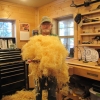Let's start at the beginning. It's true of every craft, and certainly true of carving: Every carver works with 3 things: the design; the tools and techniques; and the material - wood.
Wood. This is the stuff you work with. And you need to be totally at home and familiar with it.

| 10 August 2022 16:25
Henk - I've always bought my Lime through "specialist hardwood suppliers" (add UK for example), which you can google for. You need to buy a whole board, which for me is great because I like having some in store and know I will get through it, but that might be the thing for you going forward. (BTW Although I visit and choose the board, I usually get them to plane it up for me and deliver it. And always phone for a chat first.)
Other sources are to be found in the adverts in Woodcarving magazine or similar. Woodturners supplies have all sorts of wood blanks, including Lime, though the pieces are lathe-size, you could enquire about getting a larger piece before they dimension it.
As your real question...
The wood that to me nearest Lime is Jelutong, a Malaysian rubber species tree that's bland, pale yellow and easy to carve. Again, google "Jelutong suppliers" and again, you'll be buying a board.
Next up would be a Brazilian Mahogany - but you need to be assured it comes from a sustainable source. Its reddish of course but close clean grained, unlike African Mahoganies.
And then of course there is Oak: I use French oak which is straight and clear grained, rather than English Oak, which has a more worried grain pattern.
Finding wood to carve, and wood sources, is almost a right of passage for woodcarvers. So see yourself as Sherlock Holmes and start investigating!
Hope this helps!

| 10 August 2022 09:26
Good morning Chris,
I love to carve details and therefor Lime is my first choice. However it is difficult to get hold of lime at the moment. Can you recommend a good alternative for Lime?
Kind regards
Henk Joosten.

| 03 November 2014 16:24
Many thanks Chris the tree came down in Nonsuch Park about a year ago and is about 150 years old
i have had it cut into 3inch thick pieces about 800 long sticked them and stacked them in the garage as for sealing the ends not sure what to use for that
Regards
Cliff

| 30 October 2014 06:57
Cliff - The rule of thumb for hardwoods is to allow a year for every inch of thickness. It's just a guide; it also depends on species, how fast the tree was grown, the time of the year it was felled etc. Seal the ends, put 'in stick, under cover in a dry airy place. As for moisture content: with air drying, you can never reduce the moisture to below the ambient, which will be outdoors - that's why you want to bring your wood indoors for a while to acclimatise before carving.

| 26 October 2014 20:01
I have just got some Lime that had come down in a storm about a year ago i have had it cut into 3" thick pieces just wondering how long will it take do you think for it to reach a reasonable moisture content say 10%
cliff

| 21 January 2013 14:58
Eric - This is a good idea, thanks, but you are right in thinking I couldn't take it on. If anyone fancies the job, or has more ideas as to how it could work without becoming onerous, then let's take this out of the comments here and run it by me directly through the comments page.

| 20 January 2013 16:34
This is a general comment for the whole site, springboarding off Sharon's request. It might be cool to have a "members" section that posts selected offerings by members, the community Chris serves. There is "some work" we can do to help other carvers, especially newbees like me, who need information without taking Chris' valuable time (we want him making videos!). We can be the "grunts" that do the leg work to put together some information for others and then archive it as a PDF, etc. I am sure others would love to mention their favorite wood supplier, favorite tool, favorite carving vise, etc.

| 02 October 2012 03:01
Hugh - I often glue up wood, for the reasons you mention, or for having a thoroughly seasoned block, or simply for the size. I try my best to make the joints innocuous, through siting the join and careful matching of grain pattern and colour. And that's when I'm leaving the wood 'natural. If you are gilding or otherwise covering the surface, then there would be little reson not to take full advantage of joining to get the size or shape you want.

| 01 October 2012 14:04
If there is going to be a lot of waste when using a piece of wood is it OK to glue up a blank basic shape from several pieces, particularly if the finished carving is going to have an opaque finish and the surface of the wood will not show? I am thinking of the carved top of a mirror frame which will eventually be guilded.

| 27 January 2012 01:40
Sharon, Keep in mind that there are many and varied sources online for wood. There are firms that ship what they call 'UPS Packs' which are bundles of wood sized for the UPS delivery service to handle. When I was living in the rural south of the US, I got nearly all my wood from online sources, and not just small items - I have a piece of ash, wane-edged, 13 inches wide at one point, 18 at another, four feet long and over two inches thick. Found it on eBay for 12 dollars, with 5 more for shipping. Sources are out there to be had!
David

| 17 January 2012 09:23
Thanks for that Chris, I understand. I was thinking more along the lines of a pdf that members could access and update, adding suppliers and such like themselves.
I have tried looking for carvers and groups in my area and there doesn't really seem to be any that are particularly local, the nearest supplier I can find (at the moment) is John Boddy which is over 70 miles away.

| 14 January 2012 17:21
Sharon - We have subscribers from as far apart as Brazil and Hong Kong; Israel and Lithuania; or Australia and Sweden. So it's an impossible task for us to take on! But I do understand the anxiety new carvers have about finding suitable wood. The best advice is to 'fish where the fishes swim': Who else is carving where you live? Are there any woodcarving clubs? What do they use? Who else uses wood? Turners? Furniture makers? Where do THEY get it from? Yellow pages, Google etc. You may have to do some detective work but, then again, you only need one good source and one can usually pick up enough wood to last a few years...

| 13 January 2012 11:21
I don't know if you have time to do this but it would be really useful for us new carvers if you could provide a pdf with lists of where to buy or source wood from. One that perhaps could be added to by other members who live in other regions.
Brilliant videos as well, I've learnt so much so far. Can't wait to see the rest.
Sharon.